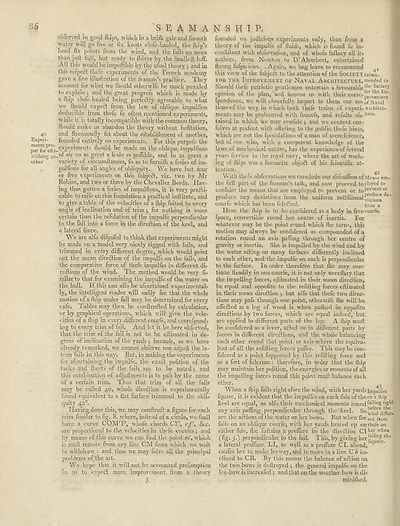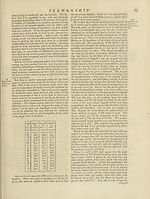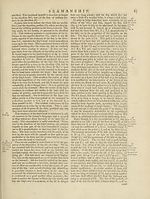Encyclopaedia Britannica, or, a Dictionary of arts, sciences, and miscellaneous literature : enlarged and improved. Illustrated with nearly six hundred engravings > Volume 19, Scripture-SUG
(94) Page 86
Download files
Complete book:
Individual page:
Thumbnail gallery: Grid view | List view

86
SEAMANSHIP.
obferved m good flaps, ivliicli in a briik gale and fniooth
■water will go five or fix knots clofe-hauled, the flap’s
bead fix points from the wind, and the fails no more
than juft full, but ready to fluvcr by the fmalleft luff.
All this would be impoffible by the ufual theory ; and in
this refpect thefe experiments of the French academy
gave a fine illuftration of the feaman’s practice. They
account for what we fhould otherwife be much puzzled
to explain ; and the great progrels which is made by
a fliip clefe-hauled being perfedlly agreeable to what
we fhould expeft from the law of oblique impulfion
deducible from thefe fo often mentioned experiments,
while it is totally incompatible with the common theory,
fhould make us abandon the theory without hefitation,
40 and ftrenuoufly fet about the eftablifhment of another,
Expert- founded entirely on experiments. For this purpofe the
per'f!)Veft.exPer^men 1:5 Ibould be made on the oblique impulfions
blifhing an-0^ ab' on as great a fcale as poflible, and in as great a
other ° variety of circumftances, fo as to furnifli a feries of im¬
pulfions for all angles of obliquity. We have but four
or five experiments on this fubjeift, viz. two by Mr
Robins, and two or three by the Chevalier Borda. Hav¬
ing thus gotten a feries of impulfions, it is very pradli-
cable to raife on this foundation a praftical inftitute, and
to give a table of the velocities of a (hip fuited to every
angle of inclination and of trim j for nothing is more
certain than the refolution of the impulfe perpendicular
to the fail into a force in the dire&ion of the keel, and
a lateral force.
We are alfo difpofed to think that experiments might
be made on a model very nicely rigged with fails, and
trimmed in every different degree, which would point
out the mean diredlion of the impulfe on the fails, and
the comparative force of thefe impulfes in different di¬
rections of the wind. The method would be very fi-
milar to that for examining the impulfe of the water on
the hull. If this can alfo be afcertained experimental*-
ly, the intelligent reader will eafily fee that the whole
motion of a fhip under fail may be determined for every
cafe. Tables may then be conftruCled by calculation,
or by graphical operations, which will give the velo¬
cities of a flap in every different courfe, and correfpond-
ing to every trim of fail. And let it be here obferved,
that the trim of the fail is not to be eftimated in de¬
grees of inclination of the yards 5 becaufe, as we have
already remarked, we cannot obferve nor adjuft the la¬
teen fails in this way. But, in making the experiments
for afcertaining the impulfe, the exact pofition of the
tacks and Hicets of the fails are to be noted ; and
this combination of adjuftments is to pafs by the name
of a certain trim. Thus that trim of all the fails
may be called 40, wiiofe direction is experimentally
found equivalent to a flat furface' trimmed to the obli¬
quity 40°.
Having done this, we may conftruCl a figure for each
trim fimilar to fig. 8. where, inftead of a circle, we {hall
have a curve COM'F', whole chords CP, cf, &c.
are proportional to the velocities in thefe courfes ; and
by means of this curve we can find the point m', which
is moft remote from any line CM from which we wifh
to withdraw : and thus we may folve all the principal
problems of the art.
Wc hope that it wall not be accounted prefumption
in us to expeCt more improvement from a theory
3
founded on judicious experiments only, than from a
theory of the impulfe of fluids, which is found fo in-
confiftent with obfervation, and of whofe fallacy all its
authors, from Newton to D’Alembert, entertained
ftvong fufpicions. .Again, we beg leave to recommend
this view of the fubjeCt to the attention of the Societyrecom-
for the Improvement of Naval Architecture.mended to j
Should thefe patriotic gentlemen entertain a favourable^ Society
opinion of the plan, sand honour us with their corre-
fpondence, we will cheerfully impart to them our no-of Naval
tions-of the wyay in which both thefe trains of experi-Architec-
ments may be profecuted with fuccefs, and refults ob-ture'
tained in which we may confide j and we content our-
felves at piefent with oft’ering to the public thefe hints,
which are not the fpeculations of a man of mere fcience,
but of one who, with a competent knowledge of the
laws of mechanical nature, has the experience of feveral
years fervice in the royal navy, where the art of work¬
ing of {hips was a favourite objedt of his fcientific at¬
tention. ^
With thefe obfervations wre conclude our difcuflion of Means em-
the firft part of the feaman’s talk, and now proceed to ployed to
confider the means that are employed to prevent or toPreventor
produce any deviations from the uniform redtilinealy™^^ e*
courfe which has been feledled. from a
Here the {hip is to be confidered as a body in free courfe.
fpace, convertible round her centre of inertia. For
whatever may be the point round which {he turns, this
motion may always be confidered as compounded of a
rotation round an axis palling through her centre of
gravity or inertia. She is impelled by the wind and by
the w^ater adling on many furfaces differently inclined
to each other, and the impulfe on each is perpendicular
to the furface. In order therefore that Ihe may con¬
tinue fteadily in one courfe, it is not only neceffary that
the impelling forces, eftimated in their mean direction,
be equal and oppofite to the refilling forces eftimated
in their mean direftion j but alfo that thefe two direc¬
tions may pafs through one point, otherwife {he will be
affefted as a log of wood is when puflied in oppofite
direftions by two forces, which are equal indeed, but
are applied to different parts of the log. A fliip muft
be confidered as a lever, adled on in different parts by
forces in different direclions, and the. whole balancing
each other round that point or axis where the equiva¬
lent of all the refilling forces paffes. This may be con¬
fidered as a point fupported by this refilling force and
as a fort of fulcrum : therefore, in order that the ftiip
may maintain her pofition, the energies or momenta of all
the impelling forces round this point muft balance each
other.
When a fhip fails right afore the wind, with her yardsimpuffes
fquare, it is evident that the impulfes on each fide of the on a fhip
keel are equal, as alfo their mechanical momenta roundrlg^
any axis palling perpendicular through the keel. ^ !.v; ml‘differ-
are the adlions of the water on her bows. But when Ihe ent from
fails on an oblique courfe, with her yards braced up onthofe on
either fide, {he fuftains a preffure in the direction Cl^er when
(fig. 5.) perpendicular to the fail. This, by giving her .°b*
a lateral preffure LI, as well as a preffure CL ahead, ^ J’
caufes her to make leeway, and to move in a line C b in¬
clined to CB. By this means the balance of adlion on
the two bows is deftroyed ; the general impulfe on the
lee-bow* is increafed •, and that on the weather-bow is dL
miniflied.
SEAMANSHIP.
obferved m good flaps, ivliicli in a briik gale and fniooth
■water will go five or fix knots clofe-hauled, the flap’s
bead fix points from the wind, and the fails no more
than juft full, but ready to fluvcr by the fmalleft luff.
All this would be impoffible by the ufual theory ; and in
this refpect thefe experiments of the French academy
gave a fine illuftration of the feaman’s practice. They
account for what we fhould otherwife be much puzzled
to explain ; and the great progrels which is made by
a fliip clefe-hauled being perfedlly agreeable to what
we fhould expeft from the law of oblique impulfion
deducible from thefe fo often mentioned experiments,
while it is totally incompatible with the common theory,
fhould make us abandon the theory without hefitation,
40 and ftrenuoufly fet about the eftablifhment of another,
Expert- founded entirely on experiments. For this purpofe the
per'f!)Veft.exPer^men 1:5 Ibould be made on the oblique impulfions
blifhing an-0^ ab' on as great a fcale as poflible, and in as great a
other ° variety of circumftances, fo as to furnifli a feries of im¬
pulfions for all angles of obliquity. We have but four
or five experiments on this fubjeift, viz. two by Mr
Robins, and two or three by the Chevalier Borda. Hav¬
ing thus gotten a feries of impulfions, it is very pradli-
cable to raife on this foundation a praftical inftitute, and
to give a table of the velocities of a (hip fuited to every
angle of inclination and of trim j for nothing is more
certain than the refolution of the impulfe perpendicular
to the fail into a force in the dire&ion of the keel, and
a lateral force.
We are alfo difpofed to think that experiments might
be made on a model very nicely rigged with fails, and
trimmed in every different degree, which would point
out the mean diredlion of the impulfe on the fails, and
the comparative force of thefe impulfes in different di¬
rections of the wind. The method would be very fi-
milar to that for examining the impulfe of the water on
the hull. If this can alfo be afcertained experimental*-
ly, the intelligent reader will eafily fee that the whole
motion of a fhip under fail may be determined for every
cafe. Tables may then be conftruCled by calculation,
or by graphical operations, which will give the velo¬
cities of a flap in every different courfe, and correfpond-
ing to every trim of fail. And let it be here obferved,
that the trim of the fail is not to be eftimated in de¬
grees of inclination of the yards 5 becaufe, as we have
already remarked, we cannot obferve nor adjuft the la¬
teen fails in this way. But, in making the experiments
for afcertaining the impulfe, the exact pofition of the
tacks and Hicets of the fails are to be noted ; and
this combination of adjuftments is to pafs by the name
of a certain trim. Thus that trim of all the fails
may be called 40, wiiofe direction is experimentally
found equivalent to a flat furface' trimmed to the obli¬
quity 40°.
Having done this, we may conftruCl a figure for each
trim fimilar to fig. 8. where, inftead of a circle, we {hall
have a curve COM'F', whole chords CP, cf, &c.
are proportional to the velocities in thefe courfes ; and
by means of this curve we can find the point m', which
is moft remote from any line CM from which we wifh
to withdraw : and thus we may folve all the principal
problems of the art.
Wc hope that it wall not be accounted prefumption
in us to expeCt more improvement from a theory
3
founded on judicious experiments only, than from a
theory of the impulfe of fluids, which is found fo in-
confiftent with obfervation, and of whofe fallacy all its
authors, from Newton to D’Alembert, entertained
ftvong fufpicions. .Again, we beg leave to recommend
this view of the fubjeCt to the attention of the Societyrecom-
for the Improvement of Naval Architecture.mended to j
Should thefe patriotic gentlemen entertain a favourable^ Society
opinion of the plan, sand honour us with their corre-
fpondence, we will cheerfully impart to them our no-of Naval
tions-of the wyay in which both thefe trains of experi-Architec-
ments may be profecuted with fuccefs, and refults ob-ture'
tained in which we may confide j and we content our-
felves at piefent with oft’ering to the public thefe hints,
which are not the fpeculations of a man of mere fcience,
but of one who, with a competent knowledge of the
laws of mechanical nature, has the experience of feveral
years fervice in the royal navy, where the art of work¬
ing of {hips was a favourite objedt of his fcientific at¬
tention. ^
With thefe obfervations wre conclude our difcuflion of Means em-
the firft part of the feaman’s talk, and now proceed to ployed to
confider the means that are employed to prevent or toPreventor
produce any deviations from the uniform redtilinealy™^^ e*
courfe which has been feledled. from a
Here the {hip is to be confidered as a body in free courfe.
fpace, convertible round her centre of inertia. For
whatever may be the point round which {he turns, this
motion may always be confidered as compounded of a
rotation round an axis palling through her centre of
gravity or inertia. She is impelled by the wind and by
the w^ater adling on many furfaces differently inclined
to each other, and the impulfe on each is perpendicular
to the furface. In order therefore that Ihe may con¬
tinue fteadily in one courfe, it is not only neceffary that
the impelling forces, eftimated in their mean direction,
be equal and oppofite to the refilling forces eftimated
in their mean direftion j but alfo that thefe two direc¬
tions may pafs through one point, otherwife {he will be
affefted as a log of wood is when puflied in oppofite
direftions by two forces, which are equal indeed, but
are applied to different parts of the log. A fliip muft
be confidered as a lever, adled on in different parts by
forces in different direclions, and the. whole balancing
each other round that point or axis where the equiva¬
lent of all the refilling forces paffes. This may be con¬
fidered as a point fupported by this refilling force and
as a fort of fulcrum : therefore, in order that the ftiip
may maintain her pofition, the energies or momenta of all
the impelling forces round this point muft balance each
other.
When a fhip fails right afore the wind, with her yardsimpuffes
fquare, it is evident that the impulfes on each fide of the on a fhip
keel are equal, as alfo their mechanical momenta roundrlg^
any axis palling perpendicular through the keel. ^ !.v; ml‘differ-
are the adlions of the water on her bows. But when Ihe ent from
fails on an oblique courfe, with her yards braced up onthofe on
either fide, {he fuftains a preffure in the direction Cl^er when
(fig. 5.) perpendicular to the fail. This, by giving her .°b*
a lateral preffure LI, as well as a preffure CL ahead, ^ J’
caufes her to make leeway, and to move in a line C b in¬
clined to CB. By this means the balance of adlion on
the two bows is deftroyed ; the general impulfe on the
lee-bow* is increafed •, and that on the weather-bow is dL
miniflied.
Set display mode to:
![]() Universal Viewer |
Universal Viewer | ![]() Mirador |
Large image | Transcription
Mirador |
Large image | Transcription
Images and transcriptions on this page, including medium image downloads, may be used under the Creative Commons Attribution 4.0 International Licence unless otherwise stated. ![]()
| Permanent URL | https://digital.nls.uk/192696504 |
|---|
| Attribution and copyright: |
|
|---|
| Description | Ten editions of 'Encyclopaedia Britannica', issued from 1768-1903, in 231 volumes. Originally issued in 100 weekly parts (3 volumes) between 1768 and 1771 by publishers: Colin Macfarquhar and Andrew Bell (Edinburgh); editor: William Smellie: engraver: Andrew Bell. Expanded editions in the 19th century featured more volumes and contributions from leading experts in their fields. Managed and published in Edinburgh up to the 9th edition (25 volumes, from 1875-1889); the 10th edition (1902-1903) re-issued the 9th edition, with 11 supplementary volumes. |
|---|---|
| Additional NLS resources: |
|

